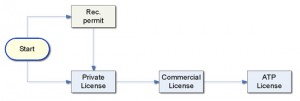
So you want to learn how to fly. Very exciting! One of the first things you should decide your motives. Deciding on what motivates you will increase your chances of successfully completing it and being inspired throughout the process.
Decide whether you want to do it as a career or for fun.
You can always change your mind, but if you are interested in a possible career or to fly at night or on instruments, consider a private license over a recreational license. A recreational license is terminal, meaning you can’t build on it, like a commercial license, do a night rating, instrument rating, and only allows you to remain VFR and it is not valid outside of Canada. It only allows you to take one passenger. The only thing you can add to a recreational license is a float endorsement.

There are four kinds of licenses you can hold:
1. Recreational Permit
2. Private License
3. Commercial License
4. Airline Transport Pilot (ATP) License
The requirements for licenses are:
| Hours: | Recreational | Private | Commercial |
| Ground School | 40 | 40 | 80 |
| Dual Instruction | 18 | 17 | 35 |
| Solo Instruction | 7 | 12 | 30 |
| Total Hours | 25 | 45 | 65 |
Remember these are minimums. Generally it takes much longer to complete the license than the minimum requirements. In addition, the faster you do the license the less hours it will take.
To apply for a CPL (commercial license), you must have a PPL. You need at least 200 total time for the CPL with a minimum of 20 hours cross country as pilot-in-command. For requirements, see Transport Canada’s licensing requirements.
In addition to the flying, you will also have to complete a ground school course – 40 hours for the recreational and private and 80 hours for the commercial is the requirement. You will have to study and write a ground school exam, and receive a 60% mark in order to pass.
Unfortunately, flying has many challenges, and this is seen in the data. Many students who start never in fact finish their license: the approximate statistic is about one in five students never finish. Most concerns are financial and the realization of the commitment required to keep up the training. Many people who complete a license never actually even use it. This is not surprising since it takes a lot of work and commitment to keep up a license.
A career as a pilot is one of the most rewarding out there!
I am not speaking from my own experience (not quite there yet!), but ask any pilot if they love their job – most love it and have wanted to fly since childhood. Of course, it isn’t an easy career. Though once seniority is gained you can earn a good salary, the beginnings are tough. Flight training can cost you close to $100,000 before you are employable to fly for a company. A PPL and CPL will cost approximately $25,000, add to that your multi-engine IFR at $13,000 and if you chose to work as an instructor to gain your flight hours and experience, your instructor rating will cost almost $7000.
Flying for fun
Flying for fun is also a great option for taking to the skies. With a PPL, you can add a night rating, IFR, multi-engine rating, VFR OTT (Over-the Top) and float plane rating.
- Night Rating: Allows you to fly at night. Requires minimum 20 hours flight time, with 13 dual and 5 hours solo. 1 hour ground school.
- Multi Engine Rating: Allows you to fly aircraft with more than one engine. There is no minimum requirement but usually takes about 10 hours. The applicant is required to pass a flight test.
- VFR OTT (Over-the-Top): As a VFR pilot you can fly over tops of clouds keeping a vertical distance of 1000′ from cloud. This gives VFR pilots lots of flexibility. Requires 15 hours of flight time.
- IFR (Instrument) Rating: Minimum 50 hours cross country PIC hours and 40 instrument hours.
- Float Rating: Minimum 7 hours and 5 solo take-offs and landings.
With the looming pilot shortage, pursuing pilot career is a very sensible choice of profession. Also if you are a female, even more opportunity is forecast. The industry is very gender- unbalanced: less than 4% of all airline pilots are female, and the industry is in need of female aviators!
Now make sure you choose the flight school that best suits your needs and a find yourself an instructor that you really like. Take your first flight and say hello to those big, wide open skies …

